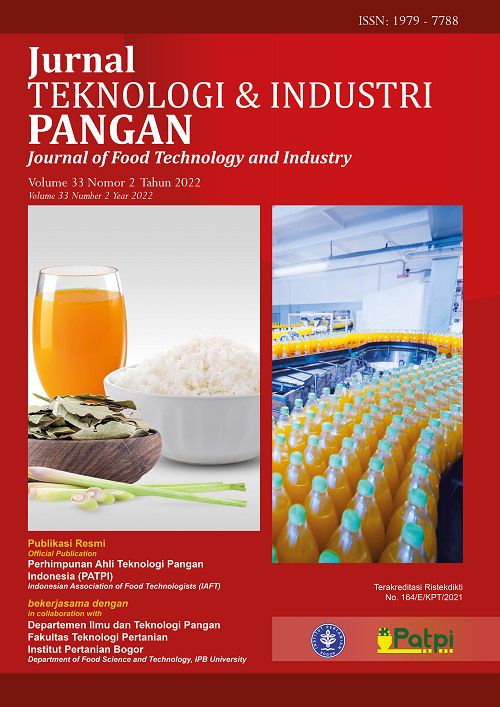Ready-To-Eat Rice in Retort Pouch Packaging as an Alternative Emergency Food Product
Abstract
Recently, the rising incidence of natural catastrophe has increased the disaster preparedness, aiming to mitigate its devastating effect. Developing an emergency food is one of meaningful attempts to rise the preparedness. This research aimed to determine the best formula of ready-to-eat rice in retort pouch packaging accepted by consumers, and to determine the operating time to reach a lethality value (F0) to meet the commercial shelf-stable food requirements as an emergency food. The thermal process adequacy (F0) was used to determine the commercial shelf-stable products according to Indonesian regulation. The results showed that the determination of ready-to-eat rice was dependent on the ratio of rice and water. The most accepted product was determined according to quality attributes and organoleptic tests applied to meet the criteria for emergency food, namely color, flavor, and texture and best perceived by consumers. A formula with 140 g of half-cooked rice and 60 g of water was attributed to the best sample, having hardness of 7305.45 gf, elasticity of 36.40%, gumminess of 2185.720 gf, and adhesiveness of -167.975 g.s. In terms of microbiological quality, the TPC for the half-cooked rice sample reached 7.2×107 CFU/mL, while cooked rice in retort pouch packaging was <25 CFU/mL. Using heat distribution curve, heating at 110°C produced a come up time (CUT) after 40 min. Furthermore, the F0 value was 4.12 which was in accordance with the Indonesian regulation.
References
Ares G, Dauber C, Fernández E, Giménez A, Varela P. 2014. Penalty analysis based on CATA question to identify drivers of liking and directions for product reformulation. J Food Qual 32: 65-76. https://doi.org/10.1016/j.foodqual.2013.05.014
Aziez AF, Indradewa D, Yudono P, Hanudin E. 2016. Uji komparasi kualitas beras varietas padi sawah yang dibudidayakan secara organik dan konvensional. J Agrineca 16: 24-37.
Biduski B, da Silva WMF, Colussi R, de Mello El Halal SL, Lim L-T, Dias ARG, da Rosa Zavareze E. 2018. Starch hydrogels: The influence of the amylose content and gelatinization method. Int J Biol Macromol 113: 443-449. https://doi.org/10.1016/j.ijbiomac.2018.02.144
[BNPB] Badan Nasional Penanggulangan Bencana. 2021. Pengetahuan Kebencanaan. https://bnpb.go.id/ [4 Januari 2021].
Fibrianto K, Syahrastani H, Nisa LA, Wahibah LY. 2019. The influence of food dimension (texture and volume) from processed rice (steamed-rice, lontong and ketupat) to the perception of satiety and consumer satisfaction level. Adv Food Sci Sustain Agric Agroindustrial Eng 2: 14-20. https://doi.org/10.21776/ub.afssaae.2019.002.01.3
Giyatmi, Anggraini D. 2017. Pengaruh jenis nasi terhadap nilai gizi dan mutu kimiawi nasi dalam kemasan selama penyimpanan sebagai alternatif pangan darurat. J Konversi 6: 31-42. https://doi.org/10.24853/konversi.6.1.31-42
Hariyadi P. 2019. Teknologi Proses Termal untuk Industri Pangan. 26-36. PT. Media Pangan Indonesia, Bogor.
Juwita L. 2020. Studi komparasi kadar glukosa pada nasi yang dimasak dengan metode rice cooker dan metode tradisional pada berbagai suhu. J Nursing Care Biomolecular 5: 25-32.
Kurniadi M, Kusumaningrum A, Nurhikmat A, Susanto A. 2019. Proses termal dan pendugaan umur simpan nasi goreng dalam kemasan retort pouch. J Riset Teknol Industri 13: 9-21. https://doi.org/10.26578/jrti.v13i1.4177
Li H, Gilbert RG. 2018. Starch molecular structure: The basis for an improved understanding of cooked rice texture. Carbohydr Polym 195: 9-17. https://doi.org/10.1016/j.carbpol.2018.04.065
Luna P, Herawati H, Widowati S, Prianto AB. 2015. Pengaruh kandungan amilosa terhadap karakteristik fisik dan organoleptik nasi instan. J Penelitian Pascapanen Pertanian 12: 1-10. https://doi.org/10.21082/jpasca.v12n1.2015.1-10
Qiu S, Punzalan ME, Abbaspourrad A, Padilla-Zakour OI. 2020. High water content, maltose and sodium dodecyl sulfate were effective in preventing the long-term retrogradation of glutinous rice grains-a comparative study. Food Hydrocolloids 98: 105247. https://doi.org/10.1016/j.foodhyd.2019.105247
Rahmadi I. 2020. Perubahan Karakteristik Fisikokimia dan Mikrobiologi Ketupat Selama Penyimpanan [Tesis]. Bogor: Fakultas Teknologi Pertanian, Institut Pertanian Bogor.
Shah MA, Bosco SJD, Mir SA, Sunooj KV. 2017. Evaluation of shelf life of retort pouch packaged Rogan josh, a traditional meat curry of Kashmir, India. Food Packag Shelf Life 12: 76-82. https://doi.org/10.1016/j.fpsl.2017.04.001
Souripet A. 2015. Komposisi, sifat fisik dan tingkat kesukaan nasi ungu. Agritekno J Teknol Pertanian 4: 25-32. https://doi.org/10.30598/jagritekno.2015.4.1.25
Stanley R, Forbes-Ewan C, McLaughlin T. 2019. Foods for the military. In Encyclopedia of Food Chemistry, eds. L Melton, F Shahidi, P Varelis. 3: 188-195. Elsevier, Amsterdam. https://doi.org/10.1016/B978-0-08-100596-5.22334-2
Sugiyono, Mariana E, Yulianto A. 2013. Pembuatan crackers jagung dan pendugaan umur simpannya dengan pendekatan air kritis. J Teknol Industri Pangan 24: 129-137. https://doi.org/10.6066/jtip.2013.24.2.129
Sutton S. 2012. The limitations of CFU: Compliance to CGMP requires good science. J GXP Compliance 16: 74-80.
Syamsir E, Valentina S, Suhutono MT. 2014. Nasi kaleng sebagai alternatif pangan darurat. J Mutu Pangan 1: 40-46.
Thomas R, Yeoh TK, Wan-Nadiah WA, Bhat R. 2014. Quality evaluation of flat rice noodles (Kway Teow) prepared from bario and basmati rice. Sains Malaysiana 43: 339-347.
Zoumas BL, Armstrong LE, Backstrand JR, Cheno-weth WL, Chinachoti P, Klein BP, Lane HW, KS Marsh MT. 2002. High-Energy, Nutrient-Dense Emergency Relief Food Product. National Academies Press, Washington DC. https://doi.org/10.17226/10347

